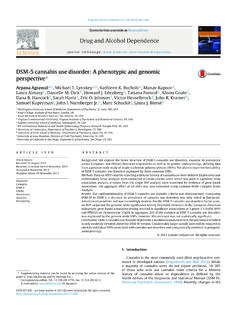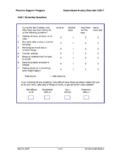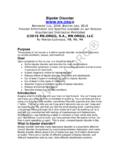Transcription of Antisocial Personality Disorder - - RN.org®
1 Antisocial Personality Disorder Reviewed September 2017, Expires September 2019 Provider Information and Specifics available on our Website Unauthorized Distribution Prohibited 2017 , , , LLC By Wanda Lockwood, RN, BA, MA The purpose of this course is to define Antisocial Personality Disorder , describe criteria for diagnosis, typical indications, and treatment approaches. Goals Upon completion of this course, the healthcare provider should be able to: List cluster B Personality disorders . Describe the DSM-IV-TR criteria for diagnosis of Antisocial Personality Disorder (ASPD). Discuss at least 5 indications of ASPD. Discuss the use of the terms sociopath and psychopath. Discuss potential causes for ASPD. List at least 5 red flags in children that may indicate increased risk of developing ASPD.
2 Discuss psychotherapy for treatment of ASPD. Discuss the use of rewards, positive feedback, limit setting, and confrontation. Discuss methods of controlling aggressive behavior. Introduction Personality is a pattern of behavior, perception, and attitudes in relation to the self, others, and the environment that is consistent across a wide range of situations. Personality disorders occur when Personality traits are inflexible and maladaptive, resulting in impaired social, academic, and employment function and emotional distress. Approximately 10-13% of the general population has a Personality Disorder , including 15% of admissions to psychiatric institutions, 40-45% of those with a major psychiatric Disorder (such as schizophrenia Purpose or bipolar Disorder ), and up to 50% of those in outpatient mental health settings.
3 Personality disorders correlate with substance abuse (70-90%), alcohol abuse (60-70%), and criminal activity (70-85%) Diagnosis of Personality Disorder is usually made 18 because the Personality is not set in adolescence; however, indications may be evident during adolescence. Most Personality disorders peak during the 20s and 30s and tend to lesson in the 40s. The American Psychiatric Association (DSM-IV-TR) classifies Personality disorders into 3 different clusters: A. Odd, eccentric behavior. B. Dramatic, emotional, or erratic behavior. C. Anxious or fearful behaviors. Cluster B Personality disorders include Antisocial Personality Disorder , borderline Personality Disorder [see CE course Borderline Personality Disorder ], histrionic Personality Disorder , and narcissistic Personality Disorder . The two most commonly found in clinical practice are Antisocial Personality Disorder and borderline Personality Disorder .
4 What is Antisocial Personality Disorder ? While a diagnosis of Antisocial Personality Disorder (ASPD) is delayed until adulthood ( 18), often alarming indications are often evident during childhood, including acts of violence and substance abuse. Parents may report that clients with ASPD threw temper tantrums and were unmanageable and unresponsive to punishment as children. Clients with ASPD typically had run-ins with the police during adolescence, sometimes including incarceration in juvenile facilities, and were often truant from schools. Some may have been diagnosed with oppositional defiant Disorder [see CE course Oppositional Defiant Disorder ] or conduct Disorder during childhood or adolescence. ASPD occurs 3 to 4 times more frequently in males than females, and up to 75% of those incarcerated are believed to have ASPD.
5 Other Cluster B disorders , such as narcissistic Personality Disorder , histrionic Personality Disorder , and borderline Personality Disorder are often co-morbidities with ASPD, making the condition even more difficult to control and increasing the predisposition toward criminal activity. Narcissistic personalities may engage in white collar crimes while those with histrionic Personality Disorder may engage in impulsive crimes or crimes to get attention. Those with borderline Personality Disorder may engage in impulsive crimes or crimes motivated by a desire for revenge. Indications of Antisocial Personality disorders DSM-IV-TR criteria A) There is a pervasive pattern of disregard for and violation of the rights of others occurring for as long as either childhood, or in the case of many who are influenced by environmental factors, around age 15, as indicated by three or more of the following: Failure to conform to social norms with respect to lawful behaviors as indicated by repeatedly performing acts that are grounds for arrest; Deceitfulness, as indicated by repeatedly lying, use of aliases, or conning others for personal profit or pleasure; Impulsivity or failure to plan ahead; Irritability and aggressiveness, as indicated by repeated physical fights or assaults; Reckless disregard for safety of self or others.
6 Consistent irresponsibility, as indicated by repeated failure to sustain consistent work behavior or honor financial obligations; Lack of remorse as indicated by being indifferent to or rationalizing having hurt, mistreated, or stolen from another; B) The individual is at least 18 years of age. C) There is evidence of conduct Disorder with onset before age 15 years. D) The occurrence of Antisocial behavior is not exclusively during the course of schizophrenia or a manic episode. Mood & affect Clients may project a mood or affect different from what they are actually feeling to correspond with what they believe is expected of them or will be to their advantage. For example, they may appear relaxed and friendly when they are, in fact, very angry. Cognitive processes While clients with ASPD do not have disordered thoughts, they have distorted perceptions of the world, which they often believe to be cold and uncaring, a justification for their behavior.
7 Clients remain oriented and tend to be of average or above-average intelligence. Judgment Clients exercise poor judgment in that they act impulsively without considering consequences of their actions, seek immediate gratification, and are attracted to thrill-seeking activities, such as extreme sports and reckless driving. They often exhibit little insight into their own problems. Roles/ Relationships Clients often have serial or simultaneous relationships but cannot sustain long-term commitments to others or achieve real intimacy and may abandon family, unable to maintain the role of spouse or parent. They often are able to gain employment but can t keep jobs because of theft, absenteeism, or boredom. Self-esteem Clients often have very low self-esteem and abuse or take advantage of other people to try to validate their own superiority.
8 Character Clients are often described as pathological liars because they have little or no respect for the truth. They may also tell lies to gain sympathy. Clients often appear as social extroverts, becoming stimulated by abuse of others. Clients typically lack feelings of remorse or guilt, regardless of their activities, and blame others for their problems. While ASPD encompasses behavior attributed to sociopaths or psychopaths, the APA does not use these terms to differentiate between behaviors, suggesting that there is simply a continuum of behavior from bad to worse. However, these terms are in common use to describe clients who exhibit Antisocial behavior, and many healthcare providers make a distinction between the two terms (with psychopath being more pathological than sociopath) although, adding to confusion, the terms are also often used interchangeably.
9 People categorized as either sociopath or psychopath have committed terrible crimes without remorse or guilt and have shown little or no Sociopath vs psychopath empathy. Some authorities believe that the distinction is that sociopaths may have some degree of empathy for family or friends while psychopaths completely lack empathy and attack family as easily as strangers. Most authorities agree that psychopaths are at the extreme end of ASPD, typically exhibiting no guilt or remorse about aberrant behavior. Ted Bundy For example, Bernard Madoff, who cheated people out of millions of dollars in an elaborate Ponzi scheme but committed no acts of violence, would probably be described as a sociopath while Ted Bundy, a notorious serial killer who disarmed people by his normal behavior and winning smile, is usually referred to as a psychopath.
10 Like Bundy, clients with ASPD may appear very charming and engaging, allowing them to take advantage of people who trust them because of their outward appearance and manner. Others put forth a more violent outward appearance to intimidate. The exact cause of ASPD has not been delineated, but it appears that it results from an interaction between genetic tendencies and the environment. Some people develop Antisocial Personality Disorder as a result of organic brain damage. Studies of those with ASPD show that the amygdala, a part of the brain that mediates learning from one s mistakes and responding to facial expressions, tends to be smaller, and this may result in a lack of empathy. However, even though the tendency toward ASPD may be there, environmental influences, such as child abuse or neglect, may be the essential trigger.
















